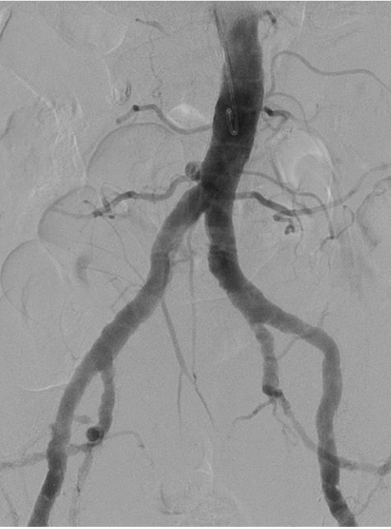Arteriography is an invasive exam that enables visualization of the aorta and arteries of the lower limbs using X-rays and iodinated contrast media. The exam is prescribed by your physician in search of arterial narrowing of the lower limbs that could explain the pain felt in your calf while walking or in case of nonhealing toe or foot wound. It enables the selection of the best treatment for your underlying pathology: medical, surgical or peripheral angioplasty.
How does an arteriography take place ?
A 12-hour hospitalization is required. You will be fasting for 6 hours prior to the exam. In order to avoid infections, a hygiene protocol is necessary, whereas a shower using an antiseptic product and shaving of both wrists (sometimes the groins) is requested.
You will be accompanied from your room to the coronary angiography laboratory by a patient attendant. After being installed on the examination table, a medication will be given by the anesthesiologist to relax you throughout the entire exam.
The arteriography is performed under local anesthesia using the left wrist as portal of entry (left radial artery). For the vast majority of patients, this exam is painless. While passing through the radial artery, you may experience a sensation of heat and/or cooling of the forearm and hand that will disappear very quickly. A small diameter catheter is positioned into the aorta under X-ray guidance. It allows to selectively inject an iodinated contrast agent in order to visualize the lower limb arteries . A large “C” shaped X-ray camera will rotate around you, enabling visualization of your arteries from several different angles. It is important to remain still during imaging acquisition in order to obtain good quality images. The table will move to image your arteries up to your foot.
At the end of the exam, the catheter is removed from the left radial artery. A compression dressing is applied on the wrist to avoid bleeding and the formation of a hematoma.
You will then return to your room for the rest of the surveillance period and the dressing will be removed 4 hours later.
In general, you are able to return home the same day after a period of surveillance of 6 hours. However, under no circumstances will you be allowed to drive.
Specific conditions
- If you are allergic to contrast media, an antiallergic preparation will be prescribed the day before the exam.
- If you have kidney failure, rehydration will be initiated the day before the exam and some of your treatments may be suspended.
- If you have diabetes, your biguanide treatment will be suspended 48 hours prior to the exam.

Is it dangerous?
Complications related to lower limb arteriography are extremely rare. They are mostly benign and local, such as bleeding or hematoma at the arterial puncture site. Rarely the artery can be injured during the examination, thus requiring emergent surgical repair or angioplasty. Allergic shock to iodinated contrast media is exceptional. All the potential complications are fully detailed in the informed consent form for the exam you are given upon admission to be signed before the procedure.
In summary
- Outpatient hospitalization
- Mean duration of the exam: 20 minutes
- The exam is painless for the majority of patients.
- A 6-hours immobilization period following the cardiac catheterization is required in order to avoid bleeding at the puncture sites.